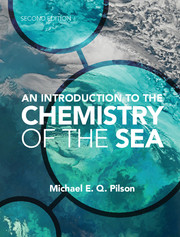Book contents
- Frontmatter
- Contents
- Preface
- Acknowledgments
- 1 Introduction
- 2 The water in seawater
- 3 Salinity, chlorinity, conductivity, and density
- 4 Major constituents of seawater
- 5 Simple gases
- 6 Salts in solution
- 7 Carbon dioxide
- 8 Nutrients
- 9 Trace metals and other minor elements
- 10 Radioactive clocks
- 11 Organic matter in the sea
- 12 Anoxic marine environments
- 13 Exchanges at the boundaries
- 14 Chemical extraction of useful substances from the sea
- 15 Geochemical history of the oceans
- Appendix A The chemical elements
- Appendix B Symbols, units, and nomenclature
- Appendix C Physical properties of seawater
- Appendix D Gases
- Appendix E Carbon dioxide
- Appendix F Dissociation constants and pH scales
- Appendix G Solubility of calcium carbonate
- Appendix H Effects of pressure
- Appendix I Radioactive decay
- Appendix J Geochemical reservoirs, and some rates
- Appendix K Sound absorption
- Epilogue
- Questions for chapters
- Glossary
- References
- Index
- Miscellaneous end matter
Appendix B - Symbols, units, and nomenclature
Published online by Cambridge University Press: 05 February 2013
- Frontmatter
- Contents
- Preface
- Acknowledgments
- 1 Introduction
- 2 The water in seawater
- 3 Salinity, chlorinity, conductivity, and density
- 4 Major constituents of seawater
- 5 Simple gases
- 6 Salts in solution
- 7 Carbon dioxide
- 8 Nutrients
- 9 Trace metals and other minor elements
- 10 Radioactive clocks
- 11 Organic matter in the sea
- 12 Anoxic marine environments
- 13 Exchanges at the boundaries
- 14 Chemical extraction of useful substances from the sea
- 15 Geochemical history of the oceans
- Appendix A The chemical elements
- Appendix B Symbols, units, and nomenclature
- Appendix C Physical properties of seawater
- Appendix D Gases
- Appendix E Carbon dioxide
- Appendix F Dissociation constants and pH scales
- Appendix G Solubility of calcium carbonate
- Appendix H Effects of pressure
- Appendix I Radioactive decay
- Appendix J Geochemical reservoirs, and some rates
- Appendix K Sound absorption
- Epilogue
- Questions for chapters
- Glossary
- References
- Index
- Miscellaneous end matter
Summary
The difficulties and confusion caused by the great variety of units, symbols, and conventions widely used in science during the last several centuries were not entirely eliminated by the introduction and spread of the metric system after the French Revolution, nor by the near universal adoption (except in the United States) of the modern metric system, the International System of Units (Système International d’Unités, abbreviated as SI). In 1960, the 11th General Conference on Weights and Measures (CGPM) adopted the abbreviation SI and specified the rules for primary and supplementary units and nomenclature; and a number of improvements and clarifications of detail have subsequently been added (Goldman and Bell 1981).
In 1960, the differing bases for the calculation of chemical masses were reconciled by definition; the mass 12 isotope of carbon was assigned the mass of precisely 12.000. The masses of all other elements or isotopes are, therefore, relative atomic masses based on the mass of carbon-12. With regard to chemical calculations and nomenclature, an important decision, formalized in 1971 (14th CGPM), was to define the mole on the basis of the previous assignment of mass 12 to the isotope 12 of carbon, and to generalize its usage. (See also Petley 1996.)
The mole is the amount of substance of a system that contains as many elementary entities as there are atoms in 0.012 kilogram of carbon-12.
When the mole is used, the elementary entities must be specified and may be atoms, molecules, ions, electrons, other particles, or specified groups of such particles.
In the definition of the mole, it is understood that unbound atoms of carbon-12, at rest and in their ground state, are referred to.
- Type
- Chapter
- Information
- An Introduction to the Chemistry of the Sea , pp. 400 - 403Publisher: Cambridge University PressPrint publication year: 2012



